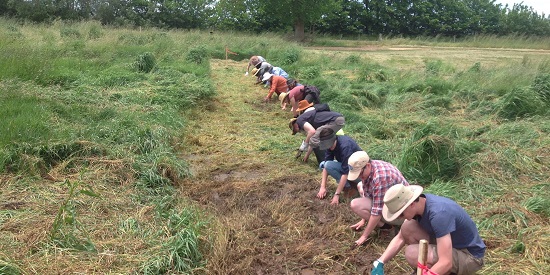Lancefield dig to unearth secrets of megafauna extinction
Media releaseA Deakin scientist hopes a palaeontological dig in central Victoria this weekend will renew a two-century long campaign to find why Australia's giant mammals died out and why so many of their remains have accumulated in one spot.
Sedimentologist Sanja Van Huet, from Deakin's School of Life and Environmental Sciences, is leading a dig at Lancefield Swamp, an area that contains one of richest deposits of megafauna fossils in Australia.
Dr Van Huet said Australian megafauna were mostly giant marsupials that lived approximately 60,000 years ago.
She is hoping that a public open day at the dig on Saturday, part of the Extinct-Lancefield Megafauna Festival, will inspire not only wider interest and ongoing funding for the dig, but will also result in important multidisciplinary research.
"People have been working on this site since the mid-1800s but it's been a very piecemeal approach with specialists working on their own individual projects and sitting apart from each other," she said.
"But this dig has generated a massive amount of interest and I've got so many high calibre colleagues wanting to take part from universities across Australia, including Monash and La Trobe.
"This could be the start of a five year project, the biggest of its kind in Australia, and we could finally put together a comprehensive idea of what happened."
Experts on the dig include archaeologists, a palynologist using fossil pollen to infer the ancient habitat, experts in megafauna DNA and dental isotopes (which can act as a climatic indicator), researchers dating the sediments and charcoals, and a taphonomist exploring the reasons for the massive accumulation of fossil material.
Sonar resonance work (measuring how fast vibrations travel through different layers under the surface) will be used to locate even more undiscovered bones.
"Scientists estimate that there could be more than 10,000 animals buried in the swamp. Although quite a few of them have been dug up - there could be many more still buried," Dr Van Huet said.
"There are lots of extinct species of kangaroo buried in the swamp, but these fossil kangaroos were twice the size of modern roos, and weighed nearly a third of a tonne.
"There were also Diprotodon, a wombat-like animal the size of a rhinoceros, and Thylacoleo, the marsupial lion. It is the largest known carnivorous Australian mammal, and had enormous slicing teeth for dispatching its prey. These animals grew to about 1.5 meters long."
Dr Van Huet said there was plenty of conjecture about why these animals died out, with scientists still debating climate change, human interaction, disease or multiple factors as the cause.
"But I'm most interested in how they were buried here. It's long been believed that this had something to do with the theory of animals gathering around a waterhole during drought conditions and then dying out once their food supply ran out," she said.
"Further work is suggesting there are many other factors involved. Our most recent excavation has uncovered fossil material mixed in with pebbles, indicating that the bones may have been washed in after an extreme weather event such as a 100 year flood. That's one of the main questions we're hoping to answer by continuing this dig."
Dr Van Huet is also hoping the Lancefield Swamp dig will inspire the next generation of Australian scientists.
"This is a great opportunity for us to bring students – from primary school kids right up to PhD candidates – and give them the opportunity to learn technical skills in the field," she said.
"With our open day on Saturday we'll be able to introduce the wider community to how palaeontologists do their work and provide a hub for people to meet and talk about megafauna. This is something that's not happening anywhere else in Australia."
Share this story

